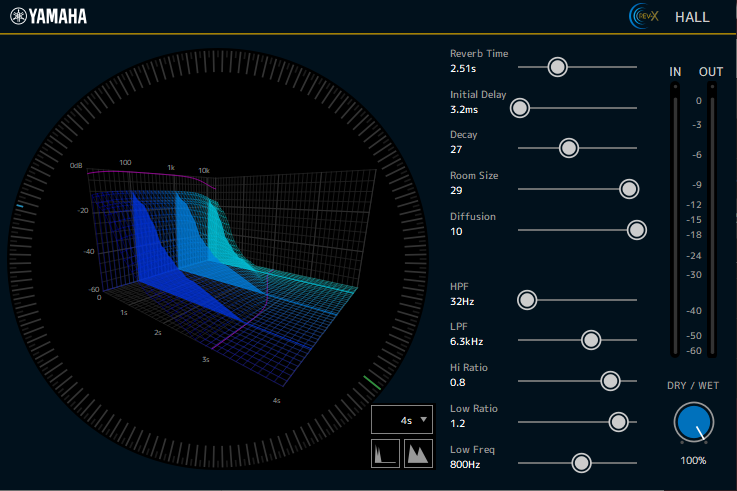Reverb Plug-ins
Reverb Plug-ins
REV-X
REV-X is a reverb algorithm with features such as sound quality with high-density and rich reverberation, smooth attenuation, and breadth and depth that make the best use of the original sound. You can select from three types of reverb according to the sound field and purpose: REV-X HALL, REV-X ROOM, and REV-X PLATE.

- EFFECT TYPE
-
Selects the effect type.
- Reverb Time
-
This is the time required for the reverberation to decay and disappear. The higher the value, the longer the reverberation will last.
- Initial Delay
-
This is the delay from the input of the original sound to the start of reverberation. The higher the value, the later the occurrence of reverberation.
- Decay
-
This is the envelope shape of the reverberation. The characteristics of the reverberation will change depending on this value.
- Room Size
-
This is the size of the room. The higher the value, the larger the simulated space. This value is linked with [Reverb Time]. Changing this value will also change [Reverb Time].
- Diffusion
-
This is the density and spread of reverberation. The higher the value, the higher the density and the stronger the sense of spaciousness.
- HPF
-
This is a filter that cuts the low-frequency components of reverberation. Components that are below the frequency specified by this value are cut. This filter has no effect on the original sound.
- LPF
-
This is a filter that cuts the high-frequency components of reverberation. Components that are above the frequency specified by this value are cut. This filter has no effect on the original sound.
- Hi Ratio
-
This is the length of the high-frequency reverberation. The high-frequency reverberation time is specified as a ratio with [Reverb Time].
- Low Ratio
-
This is the length of the low-frequency reverberation. The low-frequency reverberation time is specified as a ratio with [Reverb Time].
- Low Freq
-
This is the reference frequency for [Low Ratio]. Frequency bands below this value are affected by [Low Ratio].
- Filter Frequency Response Curve
-
The curve changes depending on the HPF and LPF values.
- Reverberation Image
-
This is an image of the reverberation of the high band (10 kHz), mid band (1 kHz), and low band (100 Hz). The image changes depending on the value of each parameter. The vertical axis represents the level, the horizontal axis represents the reverberation time, and the shape represents the envelope.
- Reverberation Time Curve
-
This curve displays the reverberation time of the high band (10 kHz), mid band (1 kHz), and low band (100 Hz).
The curve changes depending on the values for [Reverb Time], [Hi Ratio], and [Low Ratio]. - Zoom
-
Displays the length of time allocated to the time axis (horizontal axis of the graph) in seconds.
- Zoom Out Button
-
Click this button to increase the number of seconds allocated to the time axis (horizontal axis of the graph). As a result, the width of the graph is reduced.
- Zoom In Button
-
Click this button to decrease the number of seconds allocated to the time axis (horizontal axis of the graph). As a result, the width of the graph is increased.
- MIX Slider
-
Adjusts the balance between the original sound and the effect. If this value is 0%, only the original sound is output. If it is 100%, only the effect is output.
|
Manual Development Group
|
